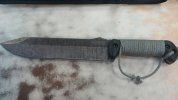- Joined
- Jul 14, 2014
- Messages
- 5,802
When deciding to purchase a bk9, then a 2 and now a 16 I spent way too much time online reading and watching reviews. I'm sure you all agree with most reviewers who loved the overall designs, value and handles. One recurring complaint about the current bk series is the thick, rough blade coating. I'd never argue with a living legend in the knife industry, but I'm just curious as to what the reasoning is behind the coating that is used.

